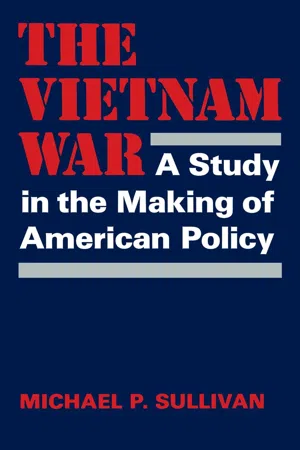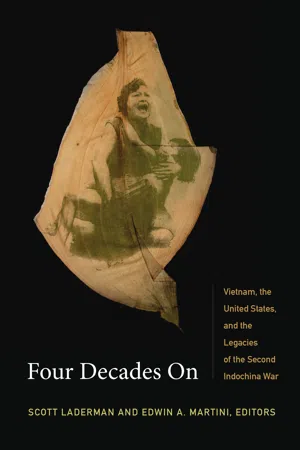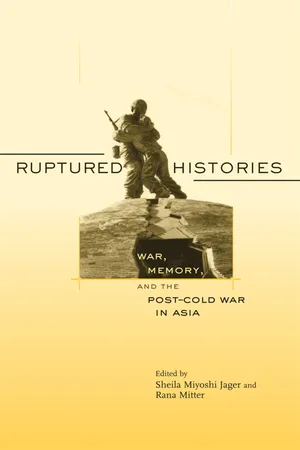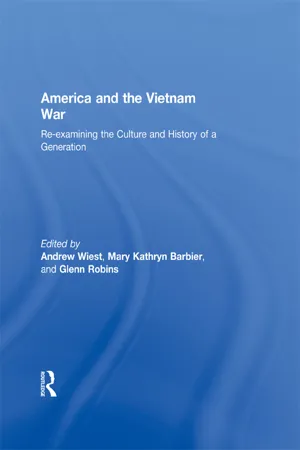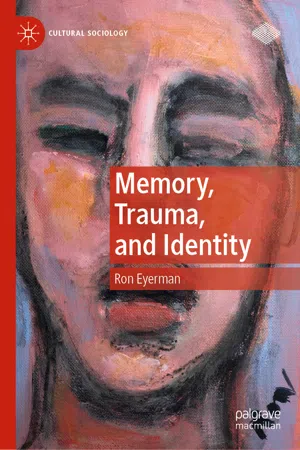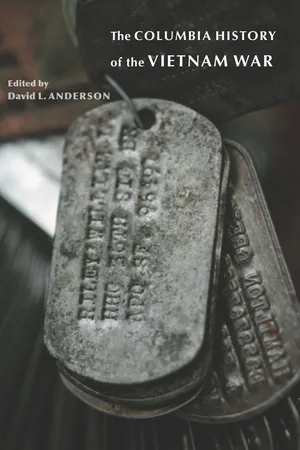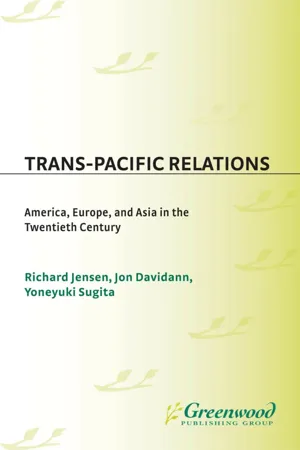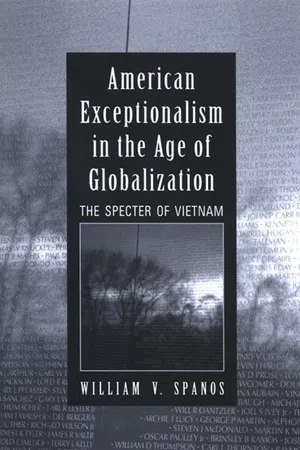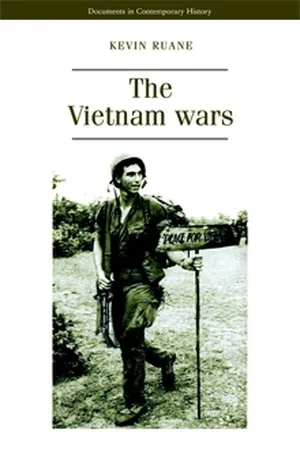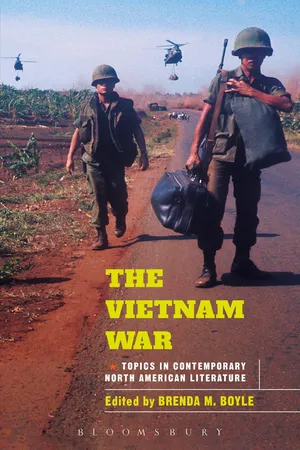History
The Vietnam War
The Vietnam War was a conflict that took place in Vietnam, Laos, and Cambodia from November 1, 1955, to the fall of Saigon on April 30, 1975. It was a prolonged and costly struggle between communist forces, supported by the Soviet Union and China, and non-communist forces, primarily supported by the United States. The war resulted in significant loss of life and had a lasting impact on the region.
Written by Perlego with AI-assistance
Related key terms
1 of 5
12 Key excerpts on "The Vietnam War"
- eBook - PDF
Secret Wars
Covert Conflict in International Politics
- Austin Carson(Author)
- 2018(Publication Date)
- Princeton University Press(Publisher)
187 6 The Vietnam War (1964–1968) With the division of Europe settled, the center of gravity in the middle period of the Cold War shifted to Vietnam.1 The fate of the former French colony of Indochina became an ideological and geopolitical struggle over the larger trajectory of Asia. Since the late 1950s, American-backed South Vietnam struggled to thwart a well-resourced and aggressive insurgency. In North Vietnam, Ho Chi Minh’s Chinese- and Soviet-backed regime en-joyed greater stability and, at least by 1960, supported the insurgency to the south. South Vietnam’s military struggles drew in outside support from the United States, which prompted corresponding aid from China and the Soviet Union to North Vietnam. After nearly a decade of counterinsurgency and conventional warfare, the Paris Peace Accords of 1973 ended an active American role. By 1975, Saigon had fallen and South Vietnam was absorbed in a final North Vietnamese offensive. The war’s historical importance is difficult to overstate. Vietnam shaped the course of the Cold War toward détente, fueled the Sino-Soviet split, undermined American willingness to intervene in other conflicts for a gen-eration, and inflicted tremendous death and destruction on populations in Southeast Asia. The war also has important value for theoretical analysis. As in the conflicts discussed in the previous two chapters, The Vietnam War features multiple interventions that both showcase the interactive nature 1 Marc Trachtenberg, A Constructed Peace: The Making of the European Settlement, 1945– 1963 (Princeton, NJ: Princeton University Press, 1999). 188 CHAPTER 6 of escalation dynamics and facilitate theoretically useful comparisons. The Vietnam War also features puzzling forms of collusion among the major adversaries as part of an overall effort to control the escalation process and avoid a larger war in Asia. This chapter focuses on the covert side of The Vietnam War, focusing on the 1964–1968 period. - eBook - ePub
The Vietnam War
A Study in the Making of American Policy
- Michael P. Sullivan(Author)
- 2021(Publication Date)
- The University Press of Kentucky(Publisher)
None of these large-scale perspectives is meant to explain the specific occurrence of The Vietnam War, when it occurred, or when it ended. Rather, these perspectives are an attempt to step back and put some envelopes around The Vietnam War and America’s involvement in order to bring to bear the broadest possible perspective.The Vietnam War AND THE COLD WAR
One generally and popularly accepted explanation of the United States’ involvement in The Vietnam War is that it flowed from the larger Cold War pitting the two largest and most powerful nations coming out of World War II against each other. While the bipolarity that emerged in the late 1940s and early 1950s was later to fade, during much of that crucial period a popular interpretation of world politics pitted the socialist, atheist, Eastern-bloc countries against the capitalist, religiously oriented, Western countries. Although it was not a complete split (the United States even provided aid to some Eastern European, Communist-bloc countries) still the political rhetoric and popular perception at the time was of a highly bipolarized world.It is interesting, then, to see exactly how The Vietnam War fits within that broader context of the East-West struggle. A brief historical review shows the Cold War to be not one single, static entity, but rather a changing, dynamic, fluctuating, interaction process. The six-year period from 1946 to 1952 was a relatively “hot” period in East-West relations, including the Russian takeover of Eastern Europe, the Berlin crisis of 1948, the formation of NATO, the Marshall Plan, and the outbreak of the Korean War. This was followed by a period of relative détente, from about 1953 to perhaps 1956, with the occurrence of the stalemate and then the cease-fire of the Korean War in 1953, the 1954 Geneva Conference to consider a settlement to the Vietnam situation, the Geneva summit of 1955, and the so-called Spirit of Camp David. The next hot period lasted from about 1956 to about 1963, and included the Russian invasion of Hungary in 1956, the downing of an American U-2 in Russia and the subsequent cancellation of the 1960 summit meeting, the Bay of Pigs, Kennedy’s bellicose speech following his summit meeting with Khrushchev in 1961, erection of the Berlin Wall of 1961, and finally the Cuban Missile Crisis of late 1962. The one exception during this period was 1959, when there was much-heralded talk of détente between East and West, which, of course, was followed by the breakup of the planned 1960 summit meeting between Premier Khrushchev and President Eisenhower because of the Russian downing of the American U-2 spy plane. - eBook - PDF
Four Decades On
Vietnam, the United States, and the Legacies of the Second Indochina War
- Scott Laderman, Edwin A. Martini, Edwin A. Martini, Scott Laderman, Edwin A. Martini, Edwin A. Martini(Authors)
- 2013(Publication Date)
- Duke University Press Books(Publisher)
Viet Nam scarcely exists in American history or memory. “Vietnam,” on the other hand, has left an indelible imprint on American history and memory. Thus, for most Americans, Viet Nam is not so much a country in Southeast Asia as it is a cultural phenomenon of their creation. Indeed, one might argue that the most important historical lesson of the “Vietnam War” (more properly the Second Indochina War or the American War) is that for Americans the conflict had little to do with Viet Nam itself.1 Indo-china, rather, functioned as a site, one of many through a long history of intervention, in which the United States carried out the drives of its mili-tant national identity. American cultural imperatives drove the decision to intervene, the conduct of the war, and the torturous path to exit the country and come to grips with its shattering impact and legacy.2 For several years now, the historiography of the American War has been trending toward de-emphasizing the notion that the United States “had to” intervene in Indochina as part of the Cold War struggle against world communism. Fredrik Logevall, Mark Bradley, Kathryn Statler, and Andrew Preston, among other scholars, emphasize that rather than being driven into the conflict by the mandates of the Cold War, the United States chose to enter into the war, often despite warnings from allies. Just why it made that decision has not been so fully explored.3 Diplomatic historians tend to focus on individual decision makers, in-Walter L. Hixson CHAPTER 2 Viet Nam and “ Vietnam ” in American History and Memory WALTER L. HIXSON 45 cluding key figures in allied nations, but especially on U.S. national secu-rity elites and, above all, on President Lyndon Johnson. The obsessive focus on Johnson reflects the traditional top-down methodology of diplo-matic history as well as the subdiscipline’s focus on government docu-ments, to the exclusion of theoretical and cultural approaches. - eBook - PDF
Ruptured Histories
War, Memory, and the Post–Cold War in Asia
- Sheila Miyoshi Jager, Rana Mitter, Sheila Miyoshi Jager, Rana Mitter(Authors)
- 2007(Publication Date)
- Harvard University Press(Publisher)
History was political, and power could be exercised to shape history how it was supposed to be. In concluding this overview, I return to my initial ob-servation of a contemporary Vietnamese state being ever more busily fixated on remembering recent wars and revolutionary sacrifices. While Vietnamese national identity with its externalization of conflict and supposedly essential antiforeign resistance impulse predates 1945, the communist movement has been most successful in using the im-agery of nationalist struggle to gain and retain power. Yet, at the begin-ning of the twenty-first century, the Party’s insistence on the centrality of this version of a Vietnamese identity reveals concerns over a society that is rapidly becoming very diverse and, in a way, less definable as a nation. The frequent invocations of war are attempts by an aging revo-lutionary generation to hold on to the power to prescribe what is prop-erly Vietnamese, who is “in” and who is “out.” As a new generation of Revolution, War, and Memory in Contemporary Viet Nam 319 more pragmatic party technocrats, whose lives have been much more defined by the 1990s than the 1960s, is poised to take leadership roles, invocations of war are meant to stay the course of the Party-led state. Evocations of war are a last attempt to drown out the wild and increas-ingly uncontrollable babble of commercialism, the Internet, and cable TV that have arisen from the new post–Cold War realities of an in-creasingly globally integrated Viet Nam. Evocations of war seek to turn a materialistic, often apolitical youth back toward revolutionary ideals. Evocations of war, tragically, seek to define narrowly a nation precisely at a moment when the country should and could make very good use of the richness and diversity of Vietnamese experiences, past and present. - eBook - ePub
Textbooks and War
Historical and Multinational Perspectives
- Eugenia Roldán Vera, Eckhardt Fuchs, Eugenia Roldán Vera, Eckhardt Fuchs(Authors)
- 2018(Publication Date)
- Palgrave Macmillan(Publisher)
2008 , 177)2.5 Results of the War
The Vietnamese history textbook devotes several passages to the North Vietnamese victory against the “American imperialist” in 1975 and its meaning (Lien et al. 2008 , 197). It explains that, with the help of the Soviet Union and other communist nations, North Vietnam succeeded in reunifying with the South and gaining independence for the whole of Vietnam. The authors end the chapter on the war with a paragraph stressing its important role in the world revolutionary movement and the national liberation movement in North and South Vietnam. In doing so, they seek to build a sense of national pride around this small country’s Resistance War, thereby constructing patriotic sentiments and esteem for the values of independence and freedom in the postwar Vietnamese generation.3 The Vietnam War in US History Textbooks
The Vietnam War has been an important theme in US history textbooks. Even though the war ended forty years ago, the debate over it has continued to this day. Researchers continue to give different perspectives on the war in Vietnam, but there is one historical fact that is not in dispute: this war has been the heaviest defeat suffered by the United States in the postwar period. This raises the question of how Americans explain The Vietnam War to younger generations in history textbooks, and approach topics such as the root of US involvement in Vietnam and how The Vietnam War had a lasting effect on the United States. This section focuses on analyzing the treatment of these issues in high school history textbooks in the United States, with a particular focus on The Americans: Reconstruction through the 20th Century (Danzer et al. 2002 ). While only one state-approved set of textbooks is allowed for use across all high schools in Vietnam , many textbooks printed by different publishing houses are used according to the demands of educational institutions in the United States. The main reason for the selection of this textbook is its popularity in secondary schools in the United States, especially in the west, where many people of Vietnamese origin live in such areas as Orange County, San José, California, and Houston, Texas - eBook - ePub
America and the Vietnam War
Re-examining the Culture and History of a Generation
- Andrew Wiest, Mary Kathryn Barbier, Glenn Robins(Authors)
- 2009(Publication Date)
- Routledge(Publisher)
If recent scholarship is any indication, the passage of time has not tempered the immediacy of The Vietnam War. While the war itself is more distant, the issues it raises are strikingly current: American hubris, failure to understand a foreign enemy, public opinion during wartime, constraints on the military. One could conclude that Iraq and Afghanistan have politicized current writing on The Vietnam War, but this misses the point. These topics stimulate debate because they are fundamental. Like any important historical topic, The Vietnam War spawned a contentious historiography because the war involved the issues that are most important to Americans.THE YEAR OF DECISIONIn Choosing War, Fredrik Logevall acknowledges the continuing resonance of The Vietnam War. He starts the book by noting that “a quarter of a century has passed since [The Vietnam War] ended for the United States, but it is still with us.”3 Logevall admits that he was surprised at his own emotional response when writing about The Vietnam War. He was distant from the war both temporally and geographically: a native of Sweden, he was born in 1963. When he started studying The Vietnam War, he explains, he had no “irreducible existential stake” in the subject.4 Nevertheless, his research led him to a disturbing conclusion: The Vietnam War was not only a tragedy, but it was one that the United States chose and therefore could have avoided.Logevall departs from recent historiographical trends by focusing on the period immediately preceding the introduction of American ground troops to Vietnam in April 1965. Many historians have chosen to look further into the past to find the roots of America’s commitment to Vietnam. Instead, Logevall examines the months from August 1963 to February 1965, a period that he dubs “the Long 1964.” It was “the most important [period] in the entire thirty-year American involvement in Vietnam, the period in which the Second Indochina War began in earnest.”5 - eBook - ePub
- Ron Eyerman(Author)
- 2019(Publication Date)
- Palgrave Macmillan(Publisher)
2016b ).This is a study of how this violent conflict and the suffering it entailed is understood and remembered collectively in American society. It is thus a study in trauma and collective memory and the social processes through which such memory is created, constructed, and maintained. As with all memory, collective memory is represented and reproduced in narrative form through various means including oral telling, literature, music, drama , film, the graphic arts, monuments, memorials, museum installations, and commemorative events such as anniversaries and holidays. Through such media and related ritual practices, the stories and myths that congeal as collective memory serve as a foundation upon which collective identity rests. In the case of nations, there is no single collective memory; rather, there are many voices that over time achieve some cohesive clarity. In this regard, one can distinguish official collectivememoryfrom popular memory (the latter is sometimes called “cultural memory”); often these two different interpretations of the past that coexist within the same society confront one another (Misztal 2003 ). This is the primary level of analysis in this article. Individual memory and the collective memory of various groups are important of course, as they contribute to collective memory , and in some cases, they offer a narrative that runs counter to official versions. For example, individually and collectively Vietnamese Americans have made various attempts to be included in official American commemorative ceremonies (for example, to participate in Veterans Day and Memorial Day parades), especially in local communities where they are a dominant presence. The published memoirs of former military officers and ordinary soldiers of the Republic of Vietnam have also been an important resource in keeping contested memories vibrant in both the U.S. and Vietnam. Antiwar activist and politician Tom Hayden, who infamously traveled to Hanoi in the midst of the war, has sought in a recently written memoir to counter the downplaying of the antiwar movement in official memorials. As these examples reveal, when publicly expressed, individual memories can be important vehicles in both supporting and countering official collective memory - Available until 27 Jan |Learn more
- David L. Anderson, David Anderson(Authors)
- 2010(Publication Date)
- Columbia University Press(Publisher)
The War That Never Ends: New Perspectives on The Vietnam War. Lexington: University Press of Kentucky, 2007.Bradley, Mark Philip, and Marilyn Young, eds. Making Sense of The Vietnam Wars: Local, National, and Transnational Perspectives. New York: Oxford University Press, 2008.Brigham, Robert K. Iraq, Vietnam, and the Limits of American Power. New York: PublicAffairs, 2008.Duiker, William J. Sacred War: Nationalism and Revolution in a Divided Vietnam. New York: McGraw-Hill, 1995.Herring, George C. America’s Longest War: The United States and Vietnam, 1950–1975. 4th ed. Boston: McGraw-Hill, 2002.Hess, Gary R. Vietnam: Explaining America’s Lost War. New York: Wiley, 2008.Karnow, Stanley. Vietnam: A History. New York: Viking, 1992.Lawrence, Mark Atwood. The Vietnam War: A Concise International History. New York: Oxford University Press, 2008.Prados, John. Vietnam: The History of an Unwinnable War, 1945–1975. Lawrence: University Press of Kansas, 2009.Schulzinger, Robert D. A Time for Peace: The Legacy of The Vietnam War. New York: Oxford University Press, 2006.——. A Time for War: The United States and Vietnam, 1941–1975. New York: Oxford University Press, 1997.Small, Melvin. Antiwarriors: The Vietnam War and the Battle for America’s Hearts and Minds. Wilmington, Del.: Scholarly Resources, 2002.Tucker, Spencer, ed. Encyclopedia of The Vietnam War: A Political, Social, and Military History. 3 vols. Santa Barbara, Calif.: ABC-CLIO, 1998.Young, Marilyn B. The Vietnam Wars, 1945–1990 - eBook - PDF
Trans-Pacific Relations
America, Europe, and Asia in the Twentieth Century
- Richard Jensen, Jon Davidann, Yoneyuki Sugita, Richard Jensen, Jon Davidann, Yoneyuki Sugita(Authors)
- 2003(Publication Date)
- Praeger(Publisher)
For general overviews of the war see George C. Herring, America's Longest War: The United States and Vietnam, 1950-1975, 3rd ed. (New York: McGraw-Hill, 1996) and Robert D. Schulzinger, A Time for War: The United States and Vietnam, 1941-1975 (New York: Oxford University Press, 1997). Two excellent reference books are Spencer Tucker, ed., Encyclopedia of The Vietnam War (New York: Ox- ford University Press; 3-vol. ed. 1998; condensed 1-vol. ed. 2000) and Stanley Kut- ler, ed., Encyclopedia of The Vietnam War (New York: Charles Scribner's Sons, 1996). The published documentation is very rich down to 1968. The Pentagon Papers: The Defense Department History of United States Decisionmaking on Vietnam (Boston: Beacon Press, 1975) is a history written by civilians at the Pentagon, with many important documents. A remarkably thorough collection of American official documents appears in the Vietnam volumes of Foreign Relations of the United States (1992-1998), published by the Department of State. The volumes for 1961, 1962, 1964, 1965, and 1966 are online at http://www.state.gov/www/about_state/ history/frusonline.html. For the military history of the war, which chiefly takes a hawkish viewpoint, start with the overviews by Shelby L. Stanton, The Rise and Fall of an American Army: U.S. Ground Forces in Vietnam, 1965-1973 (Novato, CA: Presidio Press, 1985) or Phillip B. Davidson, Vietnam at War: The History, 1946-1975 (Novato, CA: Presidio Press, 1988). The later war is well covered in Jeffrey C. Clarke, Advice and Support: The Final Years, 1965-1973 (Washington, DC: Center for Military History, 1988); Ronald Spector, After Tet: The Bloodiest Year in Vietnam (New York: Free Press, 1992); and Lewis Sorley, A Better War: The Unexamined Vic- tories and the Final Tragedy of America's Last Years in Vietnam (San Diego, CA: Harcourt Brace, 1999). - eBook - PDF
American Exceptionalism in the Age of Globalization
The Specter of Vietnam
- William V. Spanos(Author)
- 2008(Publication Date)
- SUNY Press(Publisher)
Chapter 7 CONCLUSION The Vietnam War, 9/11, and Its Aftermath Turning and turning in the widening gyre The falcon cannot hear the falconer; Things fall apart; the centre cannot hold; —W. B. Yeats, “The Second Coming” Well, if we can attrit the population base of the Viet Cong, it’ll accelerate the process of degrading the VC. —Robert Komer, head of the pacification program in Vietnam during The Vietnam War, quoted in Frances Fitzgerald, Fire in the Lake 1 The essence of American cultural history since the fall of Saigon in 1975 and the humiliating defeat the formidable U.S. army, both military and ideo- logical, suffered at the hands of an infinitely weaker opponent has been, as I have insistently observed in this book, the systematic and increasingly nu- anced forgetting of The Vietnam War, or, more precisely, the tellingly insis- tent remembering of the war that was intended to obliterate its singular history from the consciousness of the American cultural memory. This Her- culean labor to lay the Hydra-headed specter of The Vietnam War to rest— which also meant the recuperation of the disintegrated American national identity—was undertaken not only by the state (and its intellectual deputies), but also by the media, Hollywood, the publishing houses, the ed- ucational institutions—what Adorno called the “consciousness industry”— that, however invisible, are its superstructural prosthetic instruments. As I have argued elsewhere, 2 the long but uneven amnesiac representational process underwent four continuous, if uneven, phases. The first, which ac- tually preceded the end of what, after the Tet offensive of 1968, had come to be seen as a virtually unwinable war, was characterized by a belated 243 - eBook - PDF
- Kevin Ruane(Author)
- 2024(Publication Date)
- Manchester University Press(Publisher)
Thus, from 1950 onwards, the Franco-Vietminh war was simultaneously a colonial conflict and a major Cold War issue - a Sino-American war-by-proxy with the potential to escalate into a direct confrontation. This danger was particularly clear and present in 1954, when the war entered its cli- mactic phase. Despite massive US assistance, the French had been unable to wrest the military initiative from the Vietminh, whose forces 33 The Vietnam Wars controlled large swathes of rural Vietnam. Politically, the Vietminh retained a high degree of popularity and nationalist legitimacy. In France itself, meanwhile, war weariness had led to a marked growth in political and public support for a negotiated solution (2.4 ). The impending crisis finally broke on 13 March 1954 when the Vietminh attacked Dien Bien Phu, a fortress in north-west Vietnam garrisoned by 16,000 French troops, in the start of what proved to be the decisive battle of the war. French strategists had initially planned to lure the Vietminh into a set-piece confrontation where French firepower could - for once - be employed effectively; after inflicting a serious defeat on their enemy, the French could then approach negotiations from a position of mili- tary strength (an international conference was scheduled to open at Geneva on 26 April with Indochina among the top agenda items). This, at least, was the theory. But from the moment that the garrison's airstrip - its lifeline to the outside world - was put out of action, the Vietminh attackers had the French trapped in a deadly noose. For the US government, the Dien Bien Phu crisis posed an acute dilemma: policy-makers feared that defeat for the French could lead to a military rout throughout Vietnam and the loss of the keystone of Southeast Asia's Cold War security (2.5, 2.9); almost as worrying, defeat might spawn a French diplomatic capitulation to the Vietminh at the looming Geneva conference. - eBook - PDF
The Vietnam War
Topics in Contemporary North American Literature
- Brenda M. Boyle(Author)
- 2014(Publication Date)
- Bloomsbury Academic(Publisher)
“At stake,” she stresses, “is a demystification of The Vietnam War as a truth known only to veterans” (10). Other American literature and culture critics have built on those preceding them without presupposing the authority of the veteran voice. Many of these critics also use theoretical methodologies explicitly to inform their “against the grain” readings of Vietnam War literature. In Warring Fictions (1998), Jim Neilson employs a materialist methodology to investigate the publishing of Vietnam War literature, concluding that literary culture has helped to rewrite the war in accord with the needs of capital. “[T]he most consistently praised narrative prose of The Vietnam War, though critical of U.S. policy and graphic in its depictions of American atrocities,” Neilson avers, “makes only a modest critique that fits well within an elite-sanctioned doctrinal framework” (7). He indicts 1990s feminist and postcolonialist critics for overlooking “the political economy of The Vietnam War, the connections between America’s (and the West’s) economic interests and an anticommunist war in Indochina” (218), and condemns all of American literary culture for ignoring American imperialism. “Indeed,” Neilson declares, “for American literary culture it is as if there were no such thing as U.S. imperialism” (219). Mark Taylor insists in The Vietnam INTRODUCTION 17 War in History, Literature and Film (2003) that the war cannot be understood except interdisciplinarily, from the perspectives of film, history, and fiction. Using multiple perspectives exposes the hazards of single-voiced, veteran “authenticity” (27). In Masculinity in Vietnam War Narratives (2009), Brenda Boyle complicates Jeffords’s assertion by identifying in the literature not single but multiple versions of masculinities, versions predicated on interactions among identities of sexuality, race, and able-bodiedness.
Index pages curate the most relevant extracts from our library of academic textbooks. They’ve been created using an in-house natural language model (NLM), each adding context and meaning to key research topics.

